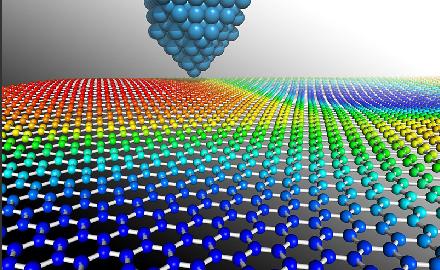The researchers were able to produce thin and transparent, electrically conductive films, which could be used to make cheaper touch screens

Technion researchers and researchers from "Rice" University in Houston, Texas, succeeded in developing an innovative method for producing relatively large quantities of carbon layers with a thickness of one atom, called "graphene". The development may lead to cheaper composite materials and touch screens. This is what the prestigious scientific journal Nature Nanotechnology reveals.
"When the layers of "graphene" are connected one on the other, they form graphite, which is the 'lead' in writing pencils," explains Professor Isaiah Talmon, head of the Russell Berry Institute for Research in Nanotechnology at the Technion and a faculty member in the Faculty of Chemical Engineering. "This has been known for hundreds of years In the years, however, it was only in 2004 that researchers were able to identify individual graphene layers. Since then, many scientists have been researching graphene, because it is a particularly strong material and also has high conductivity."
Professor Matteo Pasquali from Rice University, the research partner, says that there are methods for producing large amounts of graphene with various impurities and there are methods for producing small amounts of pure graphene (without impurities). "Our method provides an extremely pure material, and uses methods that were used in the past to produce large quantities of materials in the chemical industry," he adds. "Our research team found that graphene can be dissolved in chlorosulfonic acid, which is a well-known industrial solvent. We were surprised that individual graphene layers separated by themselves from graphite in the acid. We were able to dissolve up to two milligrams of graphene in a liter of acid, concentrations ten times greater than what can be obtained with conventional methods."
The research group used innovative methods of low-temperature electron microscopy, which allows direct imaging of the graphene layer in chlorosulfonic acid. "We used research methods we developed earlier, to image carbon nanotubes in acid," notes Professor Yachin Cohen, Dean of the Faculty of Chemical Engineering at the Technion and a member of the research team. "This is a considerable achievement considering the nature of the strong acid and the difficulties in preparing the models for the electron microscope and the imaging itself."
Using the solutions concentrated in the acid, the team was able to prepare thin and transparent, electrically conductive films. Such films could be used to make cheaper touch screens than those currently used in cell phones, for example. The researchers were also able to prepare liquid crystals of graphene in acid.
"If liquid crystals can be made, it is possible to weave them into fibers," says another researcher in the team, Professor James Tour from Rice University. "In liquid crystals, the individual layers line up so that the material can be injected through suitable nozzles for fiber spinning".
If the method proves effective for making large quantities of fibers, it will lower the price of high-strength composites used in the aerospace, automotive and construction industries.

3 תגובות
It is written that graphene is an extremely strong material. I don't remember this from my school days with the crispy spitz.
It seems to me that if there is graphene, they should first invest in the development of graphene that will create pencil tips that are more resistant.
A. cool and great
B. Two mg in a liter? And this is ten times more than it was until today?
third. I already see the next important ecological pollutant: chlorosulfonic acid
What do you have from graphene? Every Monday they publish a news story about graphene. This is already discrimination against the other elements!